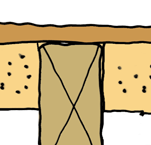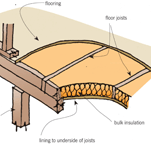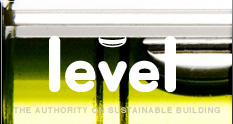- Home
- Site Analysis
- Site Use
- Passive Design
- Water
- Material Use
- Energy
- Wet Areas
- Health and Safety
- Other Resources
Passive Design
Designing the building and the spaces within it to benefit from natural light, ventilation and even temperatures.
Options for floor insulation
The type of floor insulation used will depend on whether the floor is concrete slab or a suspended timber-frame floor.
On this page:
- Insulating suspended timber-framed floors
- Insulating concrete slab floors
Timber-frame floors are typically insulated with polystyrene boards or sheet insulation made from glasswool (fibreglass), wool, polyester, wool/polyester mix, and mineral wool.
Concrete slab floors are typically insulated with polystyrene board.
For information about performance, durability and environmental properties of each material, see our insulation materials factsheet(PDF) and the materials section of this site.
Insulating suspended timber floors
Insulate suspended timber ground floors using:
- glasswool (fibreglass), wool or polyester sheets fitted between the floor joists and securely fixed or strapped in place. For very exposed subfloors, protect the insulation by fixing a sheet lining material to the underside of the joists. Check that the specific insulation products are recommended for use under floors by the manufacturer
- polystyrene panels inserted between the floor joists.

- Polystyrene insulation between joist
Polystyrene boards between joists give a moderate cost insulation option. The polystyrene must be fitted hard against the underside of the floor and should be a tight fit between joists without gaps.

- Suspended timber floor with bulk insulation and lining
For open subfloors, a sheet lining material such as plywood, tempered hardboard or fibre-cement must be used to protect the insulation.
The Acceptable Solution H1/AS1 no longer accepts the use of foil insulation (since 1 January 2017).
Insulating concrete slab-on-ground floors
Concrete slab-on-ground floors are typically insulated by placing a layer of polystyrene board over the damp-proof membrane before the slab is poured. The tables in Appendix F of H1/AS1 include calculations for R1.2 or R2.4 full cover underslab insulation and a 1.2 m wide strip of R1.2 or R2.4 underslab insulation along the slab perimeter.
BRANZ research has looked at vertical slab edge insulation for both conventional slabs and waffle slab foundations. Extruded polystyrene (XPS) was chosen for the insulation as it has a history of successful use in this application. The polystyrene was protected with 3 mm grey uPVC sheet on the outside.
Depending on the circumstances, combining underslab with slab edge insulation can result in thermal performance of the slab improving by 100% or more. Slab edge insulation can bring significant gains in energy efficiency.
Much of the thermal performance improvement can be achieved with a slab edge insulation R-value of less than 1.0. Even an R-value of 0.8 (achievable with 25 mm XPS) still provides a reasonable thermal performance improvement. See BRANZ Study Report SR352 for more details. You should note that the vertical slab edge insulation in the tables in Appendix F of H1/AS1 is based on R1.0 insulating material.
Determining under-slab insulation requirements
The construction R-values for selected generic concrete slab-on-ground floors in accordance with their individual area-to-perimeter ratios are shown in a series of tables in Appendix F in H1/AS1 5th edition amendment 1. The tables cover different:
- floor types – slab floors or concrete raft foundation floors
- floor insulation types – no insulation, R1.0 vertical edge insulation, R1.2 or R2.4 full cover underslab insulation, 1.2 m wide strip of R1.2 or R2.4 underslab insulation along the slab perimeter, a combination of edge and underslab insulation
- external wall types – the slab under masonry veneer walls has a step-down, giving it different heat transfer characteristics compared to slab floors with other types of walls, so slabs under masonry walls are therefore treated separately.
To use the tables, you need to know the slab area-to-perimeter ratio and the effective thickness of the external wall.
The slab area-to-perimeter ratio is the area of the slab inside the interior surfaces of the walls that form the thermal envelope divided by the perimeter, measuring along the interior surfaces of the walls that form the thermal envelope. Areas outside the thermal envelope such as porches or attached garages are not included in the measurements. The thickness of the external wall is measured from the interior wall surface to the exterior concrete slab vertical edge face at floor level.
The BRANZ House Insulation Guide 6th edition includes the same slab floors as H1/AS1, plus some additional ones. For example, it includes slab floors that have topper insulation on top of the slab. These additional scenarios are helpful for those that struggle to find a slab that achieves the required R-value within the H1/AS1 look-up tables.
Embedded floor heating
If embedded floor heating is incorporated in a concret/b must be insulated so that heat from the slab is delivered up into the space above and not lost to the exterior and ground below. The minimum construction R-values for heated floors are given in Table 2.1.2.2.A of H1/AS1. The calculation method cannot be used to reduce the performance of floors with embedded heating systems.
Updated: 21 August 2023

